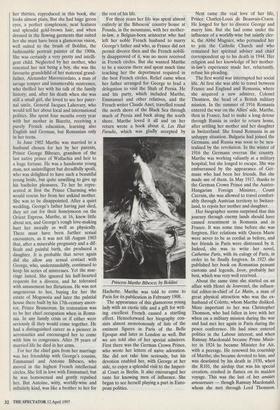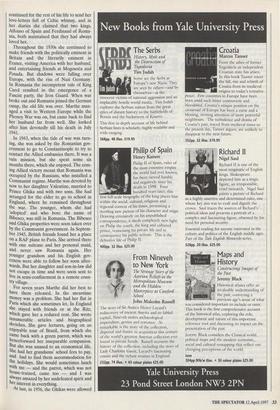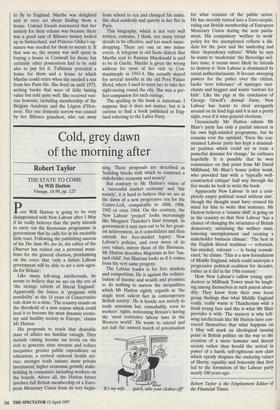SPRING BOOKS
Lady with a parrot
Steven Runciman
ENCHANTRESS: MARTHE BIBESCO AND HER WORLD by Christine Sutherland Murray, f20, pp. 318 0 ne afternoon in February 1934, I was summoned by a leading London hostess, the crimson-haired Catherine, Baroness d'Erlanger, to her house in Piccadilly, to meet someone whom, she said, I ought to know. On my arrival I was surprised to be shown straight up to the Baroness's bathroom, to find that it was temporarily her studio, in which she was Painting the portrait of a glamorous lady, introduced to me as Princess Bibesco. I was delighted to meet her. In 1919, as a schoolboy, I had attended the wedding of Elizabeth Asquith to Prince Antoine Bibesco and had noticed this splendid lady who seemed to be the bridegroom's leading female relative and had enquired who she was. Later I had read two of her novels, Le Perroquet Vert and Catherine Paris, and isvor, her account of the customs and superstitions of the Romanian peasantry, written in beautiful French; and I was going to pay my first visit to Romania later in the year. As other guests arrived and we moved from the bathroom to the drawing- room, I did not have much chance to talk to her. But she promised to welcome me in Romania if she was there, and if she was not, her daughter, Princess Ghika, would Show me round. In fact, apart from a brief meeting in Romania, I did not see her again for ten years. Marthe Bibesco deserved a biography. She. played a prominent role in France during the Belle Epoque and was a figure of international repute till her old age. She was born in January 1886. Both her Parents belonged to eminent Romanian families. When the Turks overran the Principalities of Wallachia and Moldavia ,cc011ectively to be known as Romania, as °eing the last remnants of Roum, as the Moslem world called Byzantium) they allowed them self-government under Chris- tian princes appointed by the Sultan. At first the princes were drawn from native boyar families, but by the 18th century it became the custom to appoint a Greek merchant or financier living in the Phanar quarter of• Constantinople, who could afford the large sums demanded by the Sultan for his elevation. These princes led precarious lives, some being deposed and obliged to buy back their positions, and others decapitated. So most of them when in office extracted as much money as they could from the natives and bought up estates from impoverished boyars or mar- ried their heiresses; and their descendants tended to remain in Romania. When the country became independent, under an imported Hohenzollern monarch, they pro- vided its aristocracy and most of its politi- cians. They were a cultured society, always anxious to be in touch with Western Europe and in particular with France. By the middle of the 19th century French had replaced Greek as the language that they used among themselves. Jean Lahovary, Marthe's father, belonged to a family which had been settled in Wallachia for several generations. It had never attained princely rank, but its members had always interest- ed themselves in the financial affairs of the principality and consequently, with the help of judicious marriages, had accumulated great wealth and in the 19th century pro- vided Romania with many of its statesmen. He himself was to be for many years its Minister for Foreign Affairs, and his two brothers were equally prominent. Marthe's mother, born Emma Mavrocordato, belonged to the grandest of the Phanariot princely families, a family which claimed descent from Othello, who was not a Moor but a Greek soldier surnamed Mavros, or Black, who rose in the Venetian service to be Governor of Cyprus. There he allegedly murdered his wife, who became known as Desdemona, from the Greek word for 'unfortunate'. Their grandson married a Cordato heiress from Chios and added her name to his; and their son married a Scar- latos girl whose mother belonged to the great Roman family of the Massimi. Marthe was proud of this colourful ances- try, and she was delighted when she found out that the phoenix, which was the crest of the Mavri, was also the crest of the Franco- English family of Saint-Maur, or Seymour.
Mrs Sutherland is a loyal biographer, emphasising on almost every page how beautiful and how brilliant her heroine was. In fact she was not, I think, as classically beautiful as her friend Queen Marie of Romania. Indeed in a photograph of her in her thirties, reproduced in this book, she looks almost plain. But she had huge green eyes, a perfect complexion, neat features and splendid gold-brown hair; and when dressed in the flowing garments that suited her she must have been a glamorous vision, well suited to the brush of Boldini, the fashionable portrait painter of the 1900s. She was certainly a very pretty and intelli- gent child. Neglected by her mother, who resented her not being a boy, she was the favourite grandchild of her maternal grand- father, Alexander Mavrocordato, a man of savage temper and innumerable mistresses, who thrilled her with his talk of the family history; and, after his death when she was still a small girl, she loved to see her pater- nal uncle, General Jacques Lahovary, who would tell her about local and international politics. She spent four months every year with her mother in Biarritz, receiving a purely French education, learning also English and German, but Romanian only in her teens.
In June 1902 Marthe was married to a husband chosen for her by her parents, Prince George Bibesco, grandson of the last native prince of Wallachia and heir to a huge fortune. He was a handsome young man, not unintelligent but dreadfully spoilt, who was delighted to have such a beautiful young bride, but quite unwilling to give up his bachelor pleasures. To her he repre- sented at first the Prince Charming who would rescue her from her unkind mother. She was to be disappointed. After a quiet wedding, George's father having just died, they set out for their honeymoon on the Orient Express. Marthe, at 16, knew little about sex, and George's rough love-making hurt her morally as well as physically. There must have been further sexual encounters, as it was not till August 1903 that, after a miserable pregnancy and a dif- ficult and painful birth, she produced a daughter. It is probable that never again did she allow any sexual contact with George, who, understandably, continued to keep his series of mistresses. Yet the mar- riage lasted. She ignored his half-hearted requests for a divorce, and he tolerated with amusement her flirtations. He was not ungenerous to her, buying for her the estate of Mogosoda and later the palatial house there built by his 17th-century ances- tor, Prince Brancovan. Its restoration was to be her chief occupation when in Roma- nia. In any family crisis or if either were seriously ill they would come together. He had a distinguished career as a pioneer in aeronautics and encouraged her to come with him to congresses. After 39 years of married life he died in her arms.
For her the chief gain from her marriage was her friendship with George's cousins, Emmanuel and Antoine Bibesco, who moved in the highest French intellectual circles. She fell in love with Emmanuel; but he was homosexual and gently repulsed her. But Antoine, witty, worldly-wise and infinitely kind, was like a brother to her for the rest of his life.
For three years her life was spent almost entirely at the Bibescos' country house at Posada, in the mountains, with her mother- in-law, a Belgian-born aristocrat who had left her noble French husband to marry George's father and who, as France did not permit divorce then and the French nobili- ty disapproved of it, was no more received in French circles. But she wanted Marthe to be a success there and spent much time teaching her the deportment required in the best French circles. Relief came when her father arranged for George to lead a delegation to visit the Shah of Persia. He and his party, which included Marthe, Emmanuel and other relatives, and the French writer Claude Anet, travelled round the north shore of the Black Sea through much of Persia and back along the south shore. Marthe loved it all and on her return wrote a book about it, Les Huit Paradis, which was gladly accepted by Princess Marthe Bibesco, by Boldini Hachette. Marthe was told to come to Paris for its publication in February 1908.
The appearance of this glamorous young lady with an exotic title and a gift for writ- ing excellent French caused a startling effect. Henceforward her biography con- sists almost monotonously of lists of the eminent figures in Paris of the Belle Epoque and later in London as well. But we are told also of her special admirers. First there was the German Crown Prince, who wrote her letters of naive adoration. She did not take him seriously, but his devotion enabled her, with George at her side, to enjoy a splendid visit to the Imperi- al Court in Berlin. It also encouraged her taste for knowing men of influence. She began to see herself playing a part in Euro- pean politics. Next came the real love of her life, Prince Charles-Louis de Beauvais-Craon. He longed for her to divorce George and many him. But she had come under the influence of a worldly-wise but saintly cler- ic, the Abbe Mugnier, who persuaded her to join the Catholic Church and who remained her spiritual adviser and chief correspondent up to his death in 1944. Her religion and her knowledge of her mother- in-law's experience made her, reluctantly, refuse his pleading.
The first world war interrupted her social life. At first she was able to travel between France and England and Romania, where she acquired a new admirer, Colonel Thomson, the head of a British military mission. In the summer of 1916 Romania entered the war on the Allies' side. Marthe, then in France, had to make a long detour through Russia in order to return home, after settling her mother and her daughter in Switzerland. She found Romania in an unhappy situation. Bulgaria had joined the Germans, and Russia was soon to be neu- tralised by the revolution. In the winter of 1916 the Germans overran the country. Marthe was working valiantly at a military hospital; but she longed to escape. She was embarrassed by the appearance of Ger- mans who had been her friends. But she made use of them. In May 1917, thanks to the German Crown Prince and the Austro- Hungarian Foreign Minister, Count Czernin, she was allowed to travel comfort- ably through Austrian territory to Switzer- land, to rejoin her mother and daughter.
Her biographer seems surprised that this journey through enemy lands should have caused resentment in Romania and in France. It was some time before she was forgiven. Her relations with Queen Marie were never to be as cordial as before, and her friends in Paris were distressed by it. Indeed, she was to write her novel, Catherine Paris, with its eulogy of Paris, in order to be finally forgiven. In 1923 she published her book on Romanian peasant customs and legends, Isvor, probably her best, which was very well received.
About the same time she started on an affair with Henri de Jouvenel, the influen- tial editor-in-chief of Le Matin, a man of great physical attraction who was the ex- husband of Colette, whom Marthe disliked. More important to her was Christopher Thomson, who had fallen in love with her when on a military mission during the war and had met her again in Paris during the peace conference. He had since entered politics in the Labour interest; and when Ramsay Macdonald became Prime Minis- ter in 1924 he became Minister for Air, with a peerage. He renewed his courtship of Marthe; she became devoted to him, and was desolated by his death in 1930, when the R101, the airship that was his special creation, crashed in flames on its maiden voyage. This was the last of her amities amoureuses — though Ramsay Macdonald, whom she met through Lord Thomson, continued for the rest of his life to send her love-letters full of Celtic whimsy, and in her diaries she claimed that two kings, Alfonso of Spain and Ferdinand of Roma- nia, both maintained that they had always loved her.
Throughout the 1930s she continued to make friends with the politically eminent in Britain and the literarily eminent in France, visiting America with her husband, and entertaining friends at Mogosoda and Posada. But shadows were falling over Europe, with the rise of Nazi Germany. In Romania the incompetent rule of King Carol resulted in the emergence of a Fascist party, the Iron Guard. When war broke out and Romania joined the German camp, the old life was over. Marthe man- aged a visit to Western Europe while the Phoney War was on, but came back to find her husband far from well. She looked after him devotedly till his death in July 1941.
In 1943, when the tide of war was turn- ing, she was asked by the Romanian gov- ernment to go to Constantinople to try to contact the Allied embassies there. It was a vain mission, but she spent some six months there, which she enjoyed. The com- ing Allied victory meant that Romania was occupied by the Russians, who installed a Communist regime. Marthe was devoted by now to her daughter Valentine, married to Prince Ghika and with two sons. She had arranged for the elder to go to school in England, where he remained throughout the war. The younger, whom she had 'adopted' and who bore the name of Bibesco, was still in Romania. The Bibesco and Ghika properties were soon taken over by the Communist government. In Septem- ber 1945, British friends found her a place on a RAF plane to Paris. She arrived there With one suitcase and her personal maid, and never saw Romania again. Her younger grandson and his English gov- erness were able to follow her soon after- wards. But her daughter and son-in-law did not escape in time and were soon sent to live in serni-confinement in a remote coun- try village. For seven years Marthe did her best to have them released. In the meantime money was a problem. She had her flat in Paris which she sometimes let. In England she stayed With friends or at the Ritz, Which gave her a reduced rent. She wrote Innumerable articles and biographical Sketches. She gave lectures, going on an enjoyable tour of Brazil, from which she came back with a green parrot, which was henceforward her inseparable companion. But she was unused to an economical life. She had her grandsons' school fees to pay, and had to find them accommodation for the holidays. She would sometimes lunch Nvith me — and the parrot, which was not house-trained, came too — and I was always amazed by her undefeated spirit and her interest in everything. At last, in 1956, the Ghikas were allowed to fly to England. Marthe was delighted and at once set about finding them a house. Unkind friends murmured that her anxiety for their release was because there was a good sum of Bibesco money locked up in Switzerland, and Princess Ghika's sig- nature was needed for them to secure it. If that was so, the money was well spent in buying a house in Cornwall for them; but certainly other possessions had to be sold also to pay for it. Tullimaar provided a home for them and a house to which Marthe could retire when she needed a rest from her Paris life. She lived on until 1973, writing books that were of little lasting value but sold quite well. She received vari- ous honours, including membership of the Belgian Academy and the Legion d'Hon- neur. Her one domestic sorrow was caused by her Bibesco grandson, who ran away from school to sea and changed his name. She died suddenly and quietly in her flat in Paris.
This biography, which is not very well written, contains, I think, too many trivial details to be effective, and too much name- dropping. There are one or two minor errors. A telegram in old Scots dialect that Marthe sent to Ramsay Macdonald is said to be in Gaelic. Marthe is given the wrong address for most of her visit to Con- stantinople in 1943-4. She actually stayed for several months at the old Pera Palace Hotel, where I used to meet her to take her sight-seeing round the city. She was a per- fect companion for such outings.
The spelling in the book is American. I suppose that it does not matter, but it is curious to find a book published in Eng- land referring to the Labor Party.





































































 Previous page
Previous page